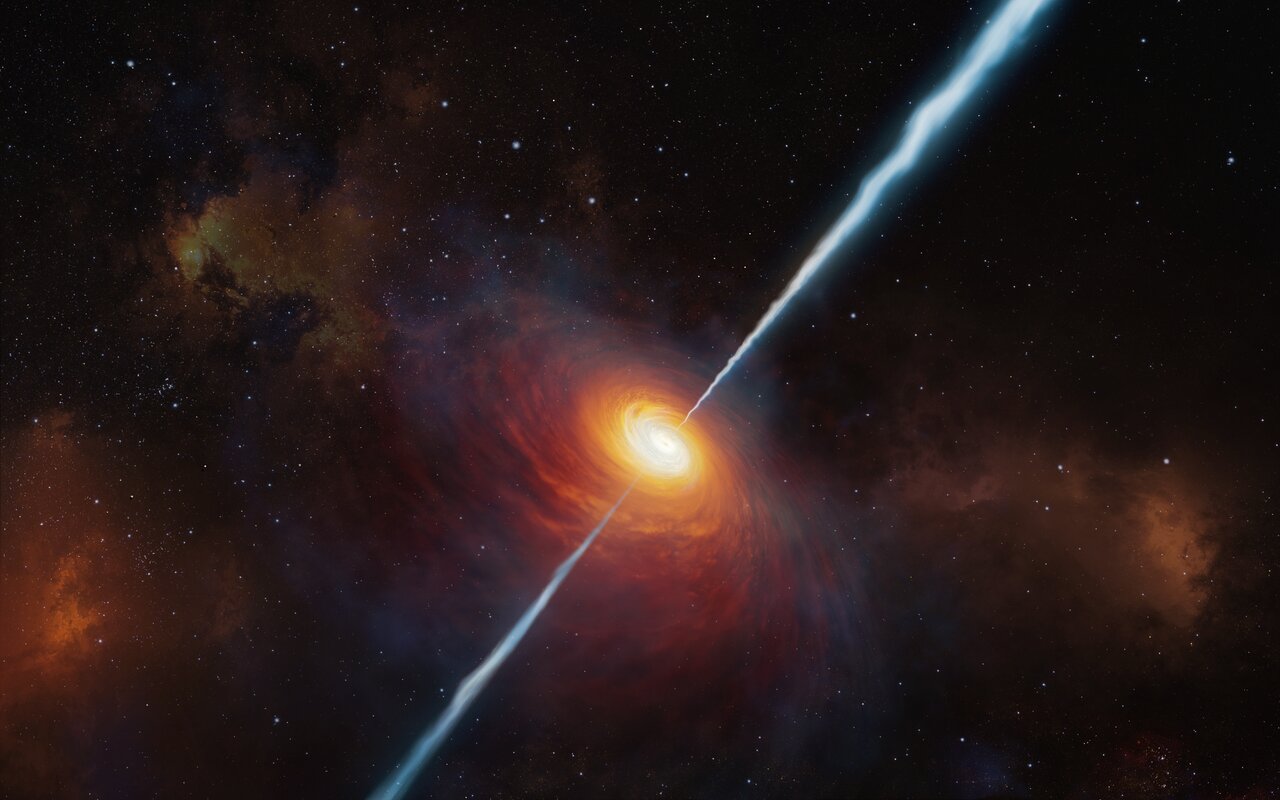Scientists find most distant quasar shooting powerful radio jets
A newly discovered quasar from the early universe is the most distant found to date that's shooting out powerful radio jets.
Astronomers using the European Southern Observatory's (ESO) Very Large Telescope (VLT) recently discovered the quasar, called P172+18, which is so far away that it takes about 13 billion years for the light from this quasar to reach Earth, where we observe the object as it was when the universe was just 780 million years old. While the new find is not the most distant quasar ever detected, it appears to be the most distant radio-loud quasar, or radio jet-emitting quasar.
Quasars are extremely bright celestial objects powered by supermassive black holes that lie in the center of some galaxies; sometimes quasars are so bright that they eclipse the very galaxies containing them. Radio-loud quasars shoot out powerful jets that are strong sources of radio-wavelength emissions. This quasar was first identified as a radio source when scientists using the Magellan Telescope at Las Campanas Observatory in Chile detected these powerful jets.
"As soon as we got the data, we inspected it by eye, and we knew immediately that we had discovered the most distant radio-loud quasar known so far," Eduardo Bañados of the Max Planck Institute for Astronomy in Germany, who led this discovery alongside ESO astronomer Chiara Mazzucchelli, said in a statement.
Related: The universe: From the Big Bang to now in 10 easy steps
The distant, jet-shooting quasar is powered by a supermassive black hole that's about 300 million times more massive than our sun and is growing quickly, pulling in and swallowing surrounding matter with its gravity.
"The black hole is eating up matter very rapidly, growing in mass at one of the highest rates ever observed," Mazzucchelli said in the same statement.
Breaking space news, the latest updates on rocket launches, skywatching events and more!
The researchers think that there could be a connection between the quick growth of black holes like this and the jets that shoot out of radio-loud quasars like P172+18, according to the statement. In particular, the astronomers think that these powerful jets might interact with nearby gases in a way that pushes the gases into the gravitational grip of these black holes, increasing how much gas falls into them.
So, as they uncover more details about this quasar, scientists will also continue to learn about the supermassive black hole accompanying it far out in the universe.
"I find it very exciting to discover 'new' black holes for the first time, and to provide one more building block to understand the primordial Universe, where we come from, and ultimately ourselves," Mazzucchelli said.
In addition to the VLT and the Magellan Telescope, which helped scientists to originally identify the radio signal that they now knows is a quasar, the team also used facilities including the National Radio Astronomy Observatory's (NRAO) Very Large Array (VLA) in New Mexico and the Keck Telescope in Hawaii.
This work was described in a paper published March 8 in The Astrophysical Journal.
Email Chelsea Gohd at cgohd@space.com or follow her on Twitter @chelsea_gohd. Follow us on Twitter @Spacedotcom and on Facebook.

Chelsea “Foxanne” Gohd joined Space.com in 2018 and is now a Senior Writer, writing about everything from climate change to planetary science and human spaceflight in both articles and on-camera in videos. With a degree in Public Health and biological sciences, Chelsea has written and worked for institutions including the American Museum of Natural History, Scientific American, Discover Magazine Blog, Astronomy Magazine and Live Science. When not writing, editing or filming something space-y, Chelsea "Foxanne" Gohd is writing music and performing as Foxanne, even launching a song to space in 2021 with Inspiration4. You can follow her on Twitter @chelsea_gohd and @foxannemusic.

